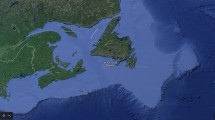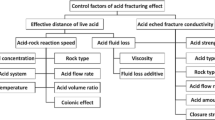During the exploitation of deep-water gas fields, the complex deep-water environment conditions result in extremely harsh requirements for the tubing selection. In this paper, the authors studied the selection of tubing in a deep-water gas field. Based on the specific practices in the deep-water gas reservoir A, they suggested the algorithm of the size selection and material selection of tubing. Assuming the flow pressure at the wellhead is 7.5 MPa, the optimized size of the tubing is selected from the most commonly used tubing sizes 5-1/2”, 7”, and 9-5/8”. The selection of the tubing size is determined by the comprehensive analysis of the tubing sensitivity, liquid-carrying capacity, and fluid erosion rate. Based on the analysis results, as well as the safety and economy issues, the 7” tubing size is regarded as the most suitable. The selection of the tubing material is determined by the analysis of the gas composition in the reservoir, the formation water characteristics, and the acid gas corrosion. The safety of the selected tubing material and the final strength of the optimized tubing are verified by the WellCat software. The results show that the strength of the 13Cr L80 tubing is satisfactory to meet the requirements for operations in the initial gas reservoir stage, the production stage, the well shut-in stage, the well killing stage, and for tubing leak situations under the conditions of different water-gas ratios. In this paper, the selection principles of the tubing size and material are summarized. The conclusions may be vitally important for improving the production safety and efficiency of the tubing, which is important in promoting the development of production technologies in the deep-water oil and gas reservoirs.





Similar content being viewed by others
References
B. Zhang, N. Lu, Y. Guo, Q. Wang, M. Cai, and E. Lou, “Modeling and analysis of sustained annular pressure and gas accumulation caused by tubing integrity failure in the production process of deep natural gas wells,” J. Energy Resour. Technol., 144(6), 063005 -063015 (2022).
J. Yang, D. Yan, R. Tian, B. Zhou, et al., “Bit stick-out calculation for the deep-water conductor jetting technique,” Pet. Explor. Dev., 40(3), 394-397 (2013).
J. Yang, W. Meng, M. Yao, et al., “Calculation method of riser top tension in deep water drilling,” Pet. Explor. Dev., 42(1), 119-122 (2015).
J. Yang, S. Liu, H. Wang, X. Zhou, Y. Song, R. Xie, Z. Zhang, Q. Yin, and F. Xu, “A novel method for fracture pressure prediction in shallow formation during deep-water drilling,” J. Energy Resour. Technol., 144(3), 033005-033018 (2022).
Q. Yin, J. Yang, M. Tyagi, et al., “Machine learning for deep-water drilling: gas-kick-alarm classification using pilot-scale rig data with combined surface-riser-downhole monitoring,” SPE J., 26(4), 1773-1799 (2021).
Q. Yin, J. Yang, Y. Yuping, et al., “Origin of H2S and corrosion analysis of tubing in offshore oilfield flooding,” Surf. Technol., 46(09), 171-178 (2017).
Q. Yin, J. Yang, X. Hou, M. Tyagi, X. Zhou, B. Cao, T. Sun, L. Li, and D. Xu, “Drilling performance improvement in offshore batch wells based on rig state classification using machine learning,” J. Pet. Sci. Eng., 192, 107306 (2020). https://doi.org/10.1016/j.petrol.2020.107306
J. Yang, “Strength and security calculation on riser with the effect of wind, wave, and current,” Chin. Offshore Oil Gas, 18(03), 198-200 (2006).
Q. Yin, J. Yang, M. Tyagi, X. Zhou, X. Hou, and B. Cao, “Field data analysis and risk assessment of gas kick during industrial deep-water drilling process based on supervised learning algorithm,” Process Saf. Environ. Prot., 146, 312-328 (2021).
N. Gong, X. Yang, J. Li, G. Wang, and H. Lin, “Tubing comprehensive optimization method for offshore oil and gas well,” Chin. Pet. Mach., 44(12), 54-58 (2016).
Q. Yin, J. Yang, S. Shanshan, et al., “Corrosion failure analysis of conductor in Eastern Oilfield in the South China Sea,” Surf. Technol., 47(11), 134-141 (2018).
X. Qiu, J. Dai, C. He, and Y. Bai, “Numerical simulation to factors influencing the gas-carrying-liquid ability in liquid-loading wells,” Well Log. Technol., 44(01), 92-97 (2020).
W. Hu, “CO2 corrosion mechanism on gas well tubing and anticorrosion measures,” Well Test. Prod. Technol., 18(002), 67-70 (1997).
Q. Wang, W. Wu, Q. Li, D. Zhang, Y. Yu, B. Cao, and Z. Liu, “Under-deposit corrosion of tubing served for injection and production wells of CO2 flooding,” Eng. Fail. Anal., 127, 105540 (2021).
A. V. Amezhnov, I. G. Rodionova, A. E. Antoshenkov, N. A. Stukalova, and Yu. S. Gladchenkova, “Influence of chemical composition and microstructure parameters of tubing steels on their corrosion resistance,” Metallurgist, 5, 1-11 (2021).
Y. Yang, X. Luo, C. Hong, A. Yadav, M. Rogowska, and R Ambat, “Characterization, formation, and development of scales on L80 steel tube resulting from seawater injection treatment,” J. Pet. Sci. Eng., 193, 107433 (2020).
J. R. Kennedy, J. B. Wiskel, D. G. Ivey, and H. Henein, “L80 pipe steel microstructure assessment using ultrasonic testing,” Mater. Sci. Technol., 35(16), 1656370 (2019).
P. Andrews, T. F. Illson, and S. J. Matthews, “Erosion–corrosion studies on 13 Cr steel in gas well environments by liquid jet impingement,” Wear, 233, 568-574 (1999).
Q. Yin, J. Yang, H. Xiu, S. Liu, Z. Li, C. Tan, T. Li, S. Zhao, T. Sun, W. Li, and S. Shi, “Material qualification of a 13Cr-L80 casing for sour conditions,” Mater. Test., 61(9), 111362 (2019).
Acknowledgments
Fund number: 2021DJ2506 Project of China National Petroleum Corporation “Key Engineering Technology of Deep-water and Ultra-deep-water Drilling in Oversea Projects”.
Fund number: 2021-168 Project of China National Oil and Gas Exploration and Development Company Ltd. “Research on Drilling Difficulties and Drilling Engineering Design of Overseas Key Exploration Wells”.
Author information
Authors and Affiliations
Corresponding author
Additional information
Translated from Khimiya i Tekhnologiya Topliv i Masel, No. 6, pp. 106–110, November-December, 2021.
Rights and permissions
About this article
Cite this article
Duan, D., Li, W., Long, Y. et al. Optimal Selection and Principles of Production Tubing in Deep-Water Gas Fields. Chem Technol Fuels Oils 57, 1013–1021 (2022). https://doi.org/10.1007/s10553-022-01338-y
Published:
Issue Date:
DOI: https://doi.org/10.1007/s10553-022-01338-y




